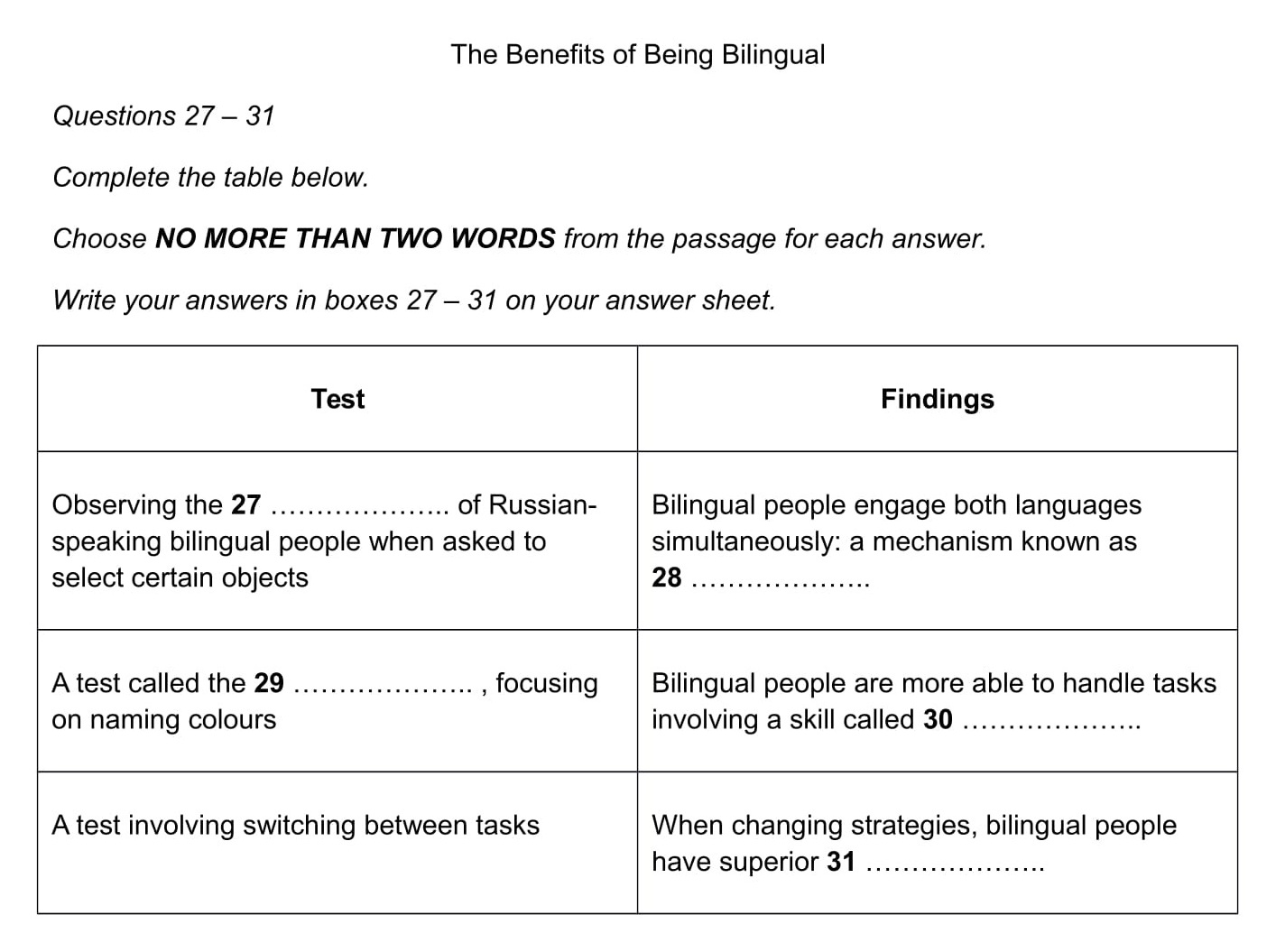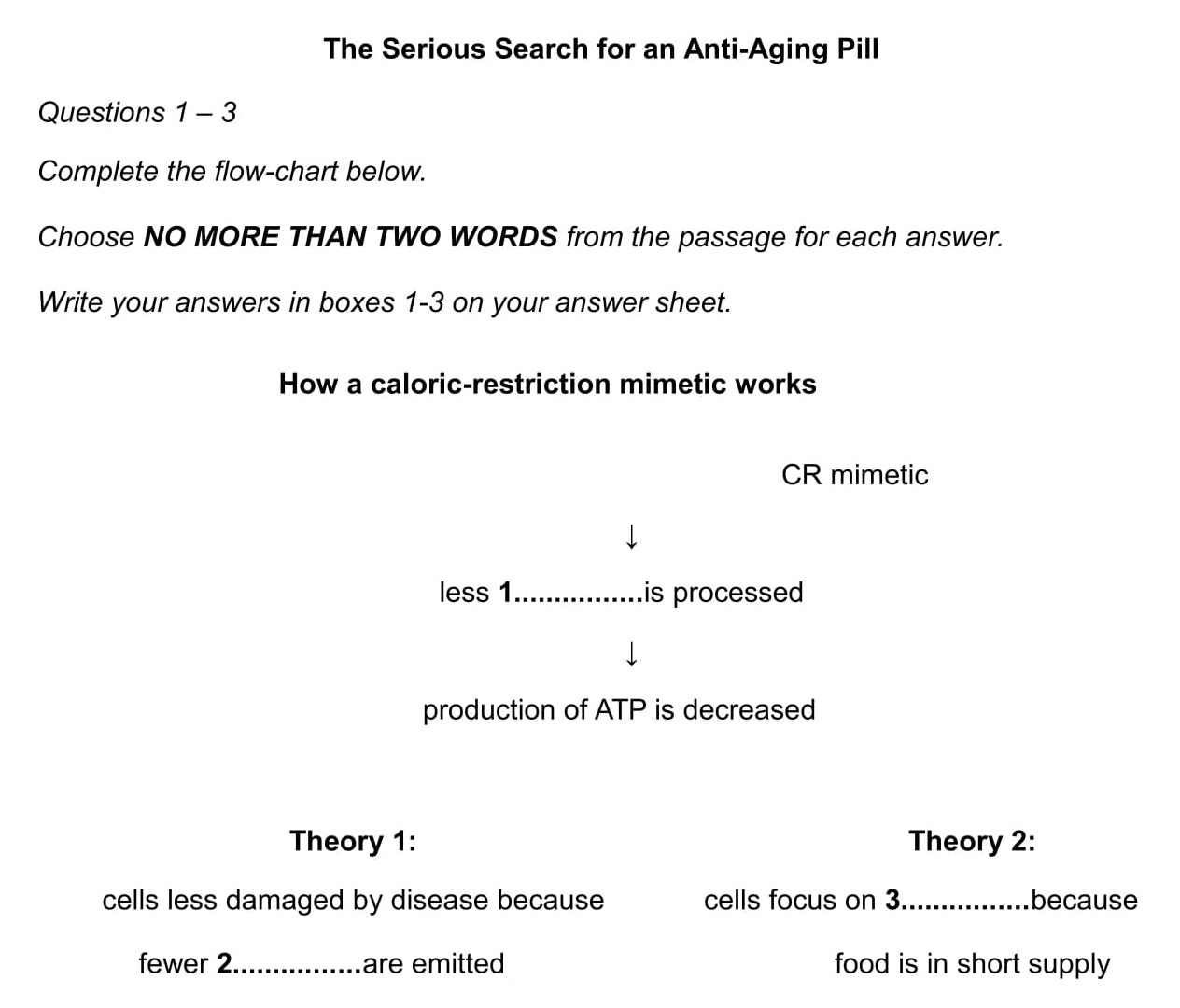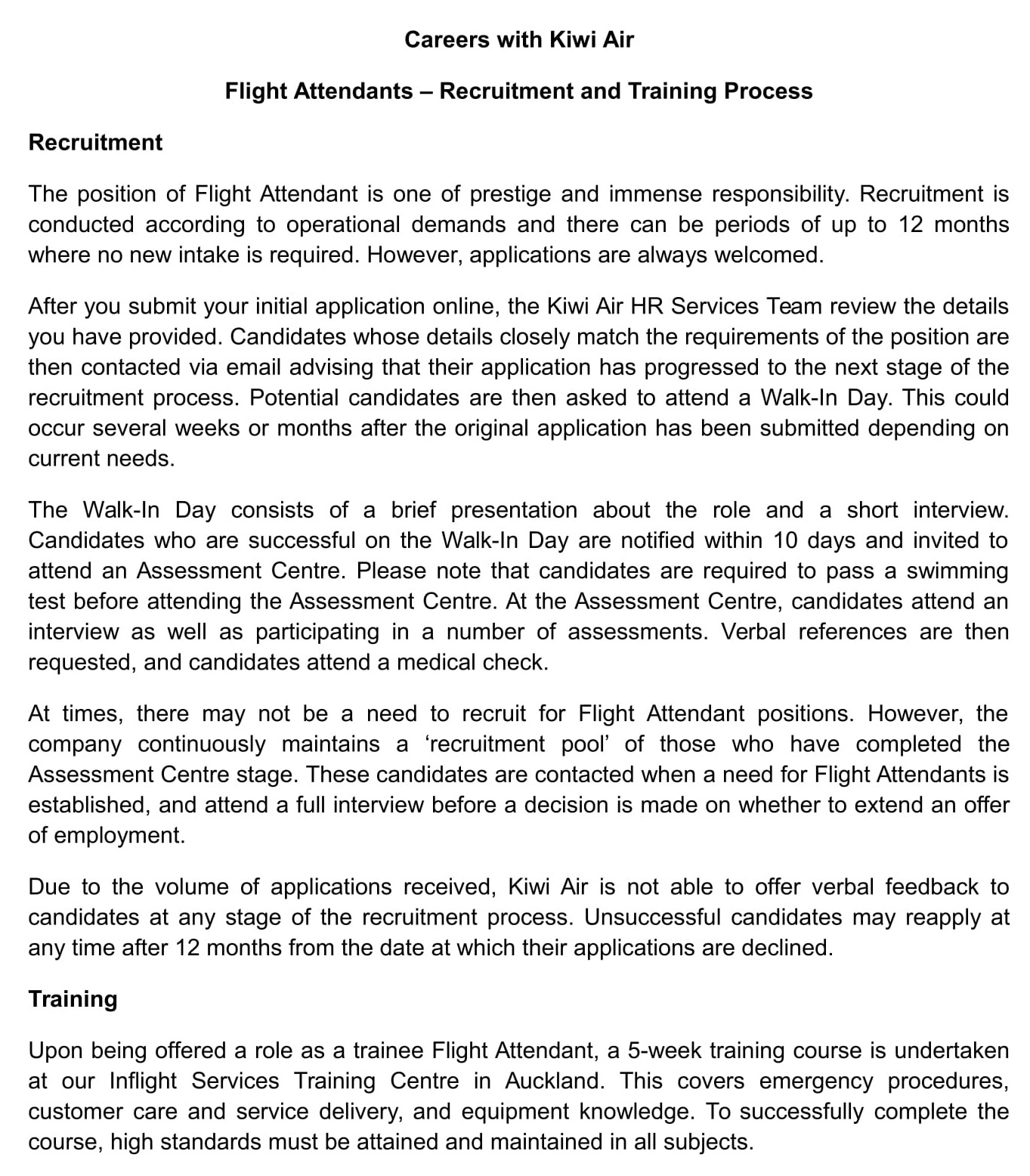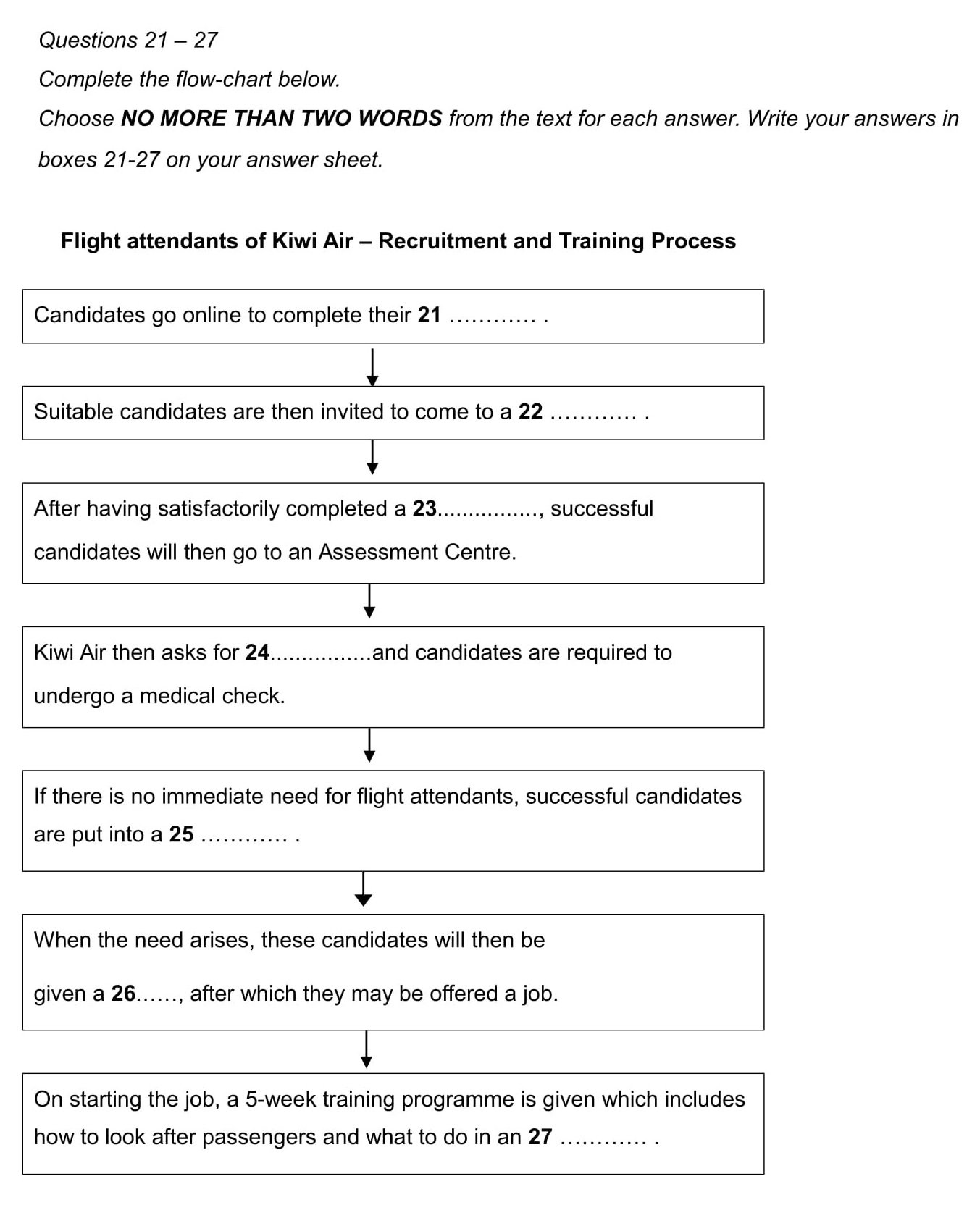IELTS Reading
Table Completion Questions
Table completion and
flowchart completion questions come up frequently in the IELTS Reading test.
They look harder than they are but as long as you understand what you have to
do and have a good strategy for completing them, you’ll be able to score well.
This page contains all the information you need to be well prepared if one does appear in your exam. Here’s what it covers:
- Explanation of this question type
- Skills needed
- Key tips
- The strategy
- Examples from real test papers
Explanation of this question type
- You will be given a table of information with gaps in it.
- You are required to fill the gaps with appropriate words from the reading text.
You
could also be given a flowchart. The main difference between the two is in the
way the information is laid out. The process for completing flowcharts is exactly the
same as with a table.
The instructions will tell you how many words you are allowed to use to fill each gap. Read them very carefully. They will most likely tell you to use ONE WORD ONLY or NO MORE THAN TWO WORDS.
If you use the wrong number of words, your answer will be marked incorrect even if the information you give is correct.
Here are examples of two sets of instructions taken from past test papers. The first is a table and the second, a flowchart.
Example 1 - Table

Source: Cambridge English Past Test Paper
Example 2 - Flowchart

Source: Cambridge English Past Test Paper
Skills needed
This type of question tests your ability to:
- Scan for specific information
- Skim for general meaning
- Understand paraphrasing
- Identify synonyms
- Read in detail for meaning
The information in the table
or flowchart will match information in the text but it will very likely be
paraphrased and include synonyms.
Once you’ve located where in the text the answer is located, you'll need to interpret the language to identify the word or words you need to fill the gap in the table or flowchart.
Key tips
1) Table completion and
flowchart questions are not as hard as they look. If you apply the step-by-step
strategy I explain below, you shouldn’t have too many problems answering them.
2) This type of question can be presented in several different forms, especially in the case of flowcharts, so may not look exactly like either of the examples I’ve given you.
Don’t panic if the layout is unfamiliar. What you need to do to complete the task will be the same however it might look.
3) The information in the table may appear in a different order to the matching information in the reading text.
4) Fill the gap with the exact words from the text. Don’t use synonyms or your answer will be marked incorrect.
5) When first studying the table, try to work out what type of word is missing, e.g. a noun, a verb, an adjective or an adverb. This will help you to find it more quickly.
6) Always be thinking about synonyms and paraphrasing. Look for matching meaning rather than exact word matches when comparing the information in the table and the text.
7) Scan to find the location of the answer, then read in detail to find the answer itself.
8) The completed sentences must be grammatically correct. If they aren’t, then you have the wrong answer.
9) Use any little clues that are present in the table to help you understand the type of information you need to find. For example,
- Column headings, such as Test and Findings in example 1 above.
- Words in bold, such as Theory 1 and Theory 2 in example 2 above.
10) You don’t need to understand everything. Even if some of the vocabulary is unfamiliar, you'll probably be able to work out the answer from context and other clues.
The Strategy
I’ll show you how to apply this strategy in the example below but first, you need to understand it.
# 1 Read the instructions carefully and note how many words you’re required to write in the gaps, e.g. NO MORE THAN TWO WORDS.
# 2 Look at the layout of the table and work out the best way to read it, particularly noting any headings that will give you clues as to its subject and content.
# 3 Quickly read through the sentences or phrases with gaps in to get a general idea of what information you’ll be looking for in the text. Try and work out what type of word is missing in each case, e.g. a noun, a verb, an adjective.
# 4 Skim read the text to get a general understanding of what it’s about and write key words or ideas beside each paragraph. This will help you to quickly find the information again later.
# 5 Go back to the table and read the first phrase or sentence with a gap in it. Select key words and scan the text for them in order to locate the paragraph that contains the answer.
The notes you wrote beside the paragraphs may also help you to identify the correct one.
# 6 Read the section of text you’ve identified in detail to find the answer. Remember that synonyms and paraphrasing may have been used.
Check that your answer makes sense, is grammatically correct and doesn’t go over the word limit.
# 7 Write your answer on the answer sheet, making sure you spell it correctly. Repeat the process to fill in the remaining gaps.
Example with answers
This practice test comes from the official IELTS website, www.ielts.org and involves completing a flowchart.
The text in your
IELTS Reading test will be longer but the number of missing words you’ll have
to find may be the same or could be fewer.
Before checking the answers, see if you can fill in the gaps in the flowchart following the steps in the strategy. When you’ve completed the task, read my notes below on how I found the answers. They include lots more tips to help you with flowchart and table completion questions.


Source: Official IELTS website ielts.org - Flowchart Completion Sample Test
Notes on how I answer the questions
1) I read the instructions carefully and note how many words I’m required to write in the gaps. In this case, it’s NO MORE THAN TWO WORDS.
I also look at the layout of the flowchart and work out the best way to read it. I take particular notice of any headings that will give me clues as to its subject and content.
In this question, we’ve been given a flowchart that lays out a recruitment process in chronological order.
2) I quickly read through the sentences with gaps in to get a general idea of what information I’ll be looking for in the text.
3) I skim read the text and note key words or ideas beside each paragraph. This will help me to quickly find the information again later. For example,
After you submit your initial application online, the Kiwi Air HR Services Team review the details you have provided. Candidates whose details closely match the requirements of the position are then contacted via email advising that their application has progressed to the next stage of the recruitment process. Potential candidates are then asked to attend a Walk-In Day. This could occur several weeks or months after the original application has been submitted depending on current needs.
online application
Walk-In Day
4) I go back to the flowchart and read the first sentence with a gap in it.
Candidates go online to complete their 21 ………… .
Since this is a flowchart containing information about a chronological process, I know that the information is most likely to come in order in the text. This is helpful to know.
I select the word ‘online’ as the key word in the statement and scan the text for it, starting with the notes I’ve made beside each paragraph.
I immediately see ‘online application’ in my notes beside paragraph 2 so scan this paragraph. I find the key word in the very first sentence. I read this paragraph in detail to find the word I need to fill the gap.

It’s clear
that the missing word is ‘application' or ‘initial application'. It
makes sense and is grammatically correct. Either is acceptable as the answer.
You can see what a time-saver making the notes can be. I didn’t even need to scan the whole text to locate this answer.
Answer 21: application or initial application
5) I read the second sentence in the flowchart.
Suitable candidates are then invited to come to a 22 ………… .
I choose the phrase ‘invited to come’ to scan for. I suspect that a synonym or other form of paraphrasing might appear in the text so am mindful of this as I scan.
I also see that my next recorded note beside the text is ‘Walk-In Day’ and predict that this could be a good fit for the sentence.
I scan from the location of the first answer in paragraph 2 and soon spot the phrase ‘asked to attend’ which means the same as ‘invited to come’.

Candidates are ‘asked to attend’ a ‘Walk-In Day’ so my prediction was correct and this is the answer. Note that hyphenated words such as ‘walk-in’ count as one word so I’m within the words limit.
I fill in my answer and move on.
Answer 22: walk-in day
6) I now read the third sentence and chose ‘Assessment Centre' for my key words.
After having satisfactorily completed a 23................... , successful candidates will then go to an Assessment Centre.
I can see from my notes that ‘Assessment Centre’ appears in the next paragraph so I don’t actually need to scan for it.
I go back to the sentence and select another set of key words to help me locate the answer. I choose ‘satisfactorily completed’ which comes immediately before the missing word so directly relates to it.
I now scan the paragraph for these keywords or synonyms of them.

The
information in this paragraph needs a bit more interpretation than for the
previous answers because the matching information in the text contains a
synonym and is also paraphrased.
However, once I spot the phrase ‘required to pass’, which means the same thing as ‘satisfactorily completed’ and occurs in a sentence also containing ‘Assessment Centre’, I read in detail to find the answer. It is clearly ‘swimming test’.
Answer 23: swimming test
7) For answer 24, the obvious key word to scan for is ‘medical check’. It should be easy to spot this or a synonym. As before, I start to scan from the location of the last answer.
Kiwi Air then asks for 24............. and candidates are required to undergo a medical check.
I don’t have to scan far as it is just two sentences further on at the end of the paragraph. I now know where the answer is and read the sentence in detail to check that the information matches the gap sentence.

Although ‘medical check’ has not been
changed, there are a couple of synonyms present:
- requested – asks for
- attend (a medical check) – undergo (a medical check)
I’m happy that I have a match of information and look to see what is ‘asked for/requested’. It’s ‘verbal references’ so this is the answer.
Answer 24: verbal references
8) Sentence 25 has no obvious key word to scan for so, having read it to get a general sense of its meaning, I go to the text and look for a matching idea in my notes.
If there is no immediate need for flight attendants, successful candidates are put into a 25 ………… .
There is a match. ‘no immediate need for flight attendants’ in the sentence means the same as ‘not hiring now’ in my notes. I guess that the other part of my notes, ‘recruitment pool’, could actually be the answer. It makes sense in the sentence and is grammatically correct.

I read this section of the text in detail and find that I'm right. The answer is ‘recruitment pool’.
Answer 25: recruitment pool
9) For answer 26, I choose the phrase ‘offered a job’ to scan for. I guess that a synonym or paraphrasing will very likely be used instead so am mindful of this as I search.
When the need arises, these candidates will then be given 26 ………….. , after which they may be offered a job.
A short way on from the last answer, I find a matching
phrase – ‘extend an offer of
employment’.

I now need to
read in detail to find out what happens to the candidates before this job
offer which is what sentence 26 is about. The answer is, they attend a ‘full
interview’. Does this fit the gap in the sentence? Yes.
So, the answer is, ‘full interview’.
Answer 26: full interview
10) Finally, I read sentence 27.
On starting the job, a 5-week training programme is given which includes how to look after passengers and what to do in an 27 ………… .
I remember that one of the paragraphs in the text is titled ‘Training’ so I go straight to this section and see that I’ve noted ‘5-week training course’ beside the paragraph.
'Course' is a synonym of 'programme'.
This must definitely be the location of the answer.

I read the paragraph in detail and find four things named as being included in the course:
- emergency procedures
- customer care
- service delivery
- equipment knowledge
The only word
from this list that makes sense and is grammatically correct in the gap
sentence is ‘emergency’. This
must be the answer.
Note the indefinite article ‘an’ before the gap. This means that the missing word must start with a vowel. This is another little clue that ‘emergency’ is the correct answer.
I fill in the answer sheet and the question is complete.
Answer 27: emergency
Answers
21 (initial) application
22 Walk-In Day
23 swimming test
24 verbal references
25 recruitment pool
26 full interview
27 emergency
Want to watch the video of this page? Click here.
I hope you’ve found these extra notes helpful. However, you will only get better at answering table and flowchart completion questions if you practice the strategy yourself. Make this a part of your preparation work and you should do well in your IELTS Reading test.
Like this page?
Lessons On All Question Types
For more sample questions with step-by-step instructions, see the IELTS Reading menu page.
More Reading Test Pages
IELTS Reading Test – Understand the format, question types & marking system & know what skills are assessed. Also learn success strategies, key reading skills & discover top tips.
IELTS Reading Skills – Master the skills of skimming, scanning & detailed reading. Understand the importance of topic sentences & how to use context for meaning & unfamiliar words.
Top 7 IELTS Reading Tips – Each tip will take you a step closer to the high score you want. They are the key to top marks in your test.
9 More Tips For IELTS Reading – Learn valuable practice techniques & discover a secret that may gain you extra marks.
IELTS Reading Practice – Discover the top 5 things you must do to prepare for your reading test.
How to Complete the IELTS Reading Test in 60 Minutes – Top 6 Recommendations.
IELTS Academic Reading – Why you should take IELTS Academic Reading, test format, text types &
sample tests.
IELTS General Reading – Why you should take IELTS General Reading, test format, text types & sample tests.
Reading Practice Samples – Short activities to improve your reading skills & help you learn topic vocabulary.









